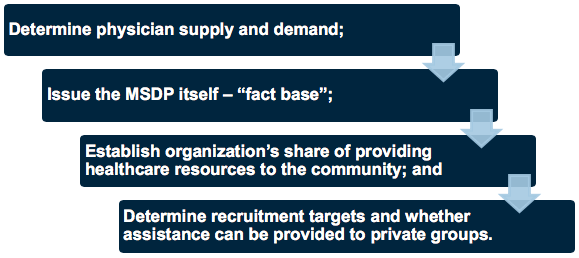Author: Kevin Loeffler
Meeting Community Needs
In our rapidly changing healthcare environment, adaptation of new integrated delivery models is essential for meeting patient care standards while concurrently running a successful operation. Add to that the recent requirements established in the Patient Protection and Affordable Care Act that call for qualifying healthcare organizations to conduct a Community Health Needs Assessment ("CHNA") every three years, and hospital-physician relationships have never been more important. A key strategy to strong physician relations is the knowledge of physician resource needs as they apply to the community served and the goals and strategy behind hospital-physician alignment.
Why IS Physician Resource Planning Important?
Required by healthcare reform law
With the passage of the Patient Protection and Affordable Care Act, a CHNA is no longer an elective process for hospitals that meet the requirements of a 501(c)(3) organization under the Internal Revenue Code. Such organizations are required to conduct a CHNA every three years and adopt an implementation strategy to meet the community health needs identified through such an assessment. Failure to do so could result in a hefty excise tax of $50,000. In addition to ensuring regulatory compliance under the Patient Protection and Affordable Care Act, a well-designed CHNA, to include a Medical Staff Development Plan ("MSDP"), will likely assist an organization with respect to its compliance obligations related to physician financial arrangements under both the IRS Code as well as Stark and the Anti-Kickback Statute.
Establish recruitment action plan and integration of needed healthcare professionals into community
A CHNA projects the local and/or regional needs for healthcare resources. The use of a MSDP, an enhancement many times included as part of a CHNA, will specifically provide strategic direction concerning the recruitment and retention of medical staff in accordance with community and hospital needs. A healthcare organization can utilize a MSDP to:
- Facilitate strategic and business planning efforts
- Develop strategies toward physician-hospital alignment
- Differentiate clinical service offerings from competitors
- Identify allied health practitioner needs
- Documenting private practice recruitment support payments
Medical Staff Development Plan Structure / Process / Policy
Structure
A well-designed medical staff development plan should include, at minimum, the following components:



